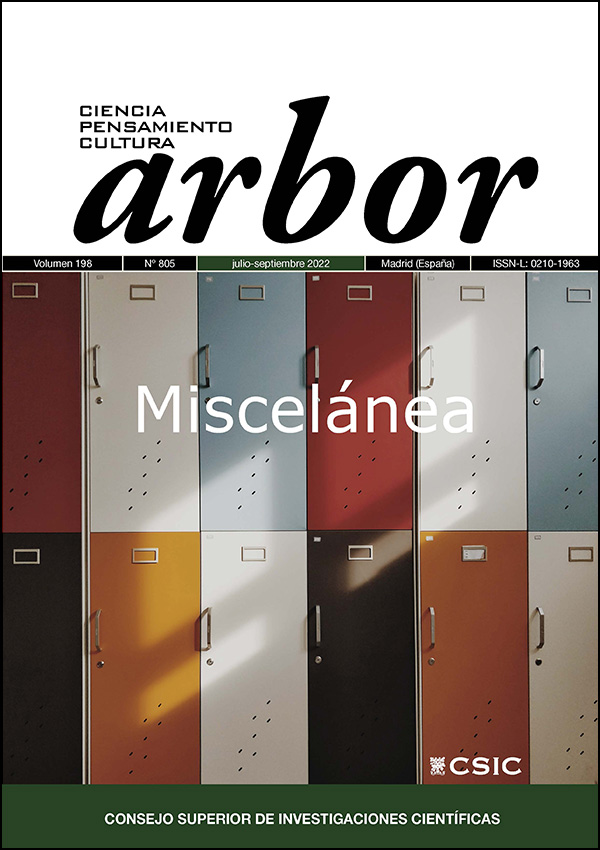Analysis of indicators to promote Scientific Culture: a decade of activity in the CSIC
DOI:
https://doi.org/10.3989/arbor.2022.805015Keywords:
Scientific Culture, scientific dissemination, indicators, CSICAbstract
Activities to promote Scientific Culture have become common practice in research institutes, which allocate financial and human resources to them. Scientific and technical staff increasingly incorporate this mission into their traditional research and teaching tasks. However, while research and teaching have established indicators, Scientific Culture activities are still considered unusual and are rarely recognized at an institutional level. In this sense, we believe that developing indicators for Scientific Culture would help change this situation and obtain objective data that could be used to orient social communication actions in science.
The Consejo Superior de Investigaciones Científicas (CSIC), through its Deputy Vice Presidency of Scientific Culture, has proposed an analysis of the activities developed that help define appropriate Scientific Culture indicators. The CSIC has classified the Scientific Culture activity undertaken between 2011 and 2019, using the following indicators: 1) financial investment; (2) staff dedicated to Scientific Culture; (3) the number and type of activities held; and (4) the public reached. Among the main conclusions, we can highlight that the CSIC has a fairly stable critical mass of about 200 people who are dedicated to Scientific Culture endeavours. Every year around 15,000 activities are carried out (in-person and virtual) with the participation of around 3,000 CSIC workers. Each year more than a million and a half people attended in-person activities. 2020 will be the subject of an individualized study, as the special circumstances of the COVID-19 pandemic have made it a unique exercise with its own analysis identity.
Downloads
References
Ambruster-Domeyer, Heidi; Hermansson, Karin y Modeer, Camilla (2011). Samverkan-Public Engagement. International review, analysis and proposals on indicators for measuring public engagement. VA Report. Stockholm.
Bauer, Martin W.; Allum, Nick y Miller, Steve (2007). What can we learn from 25 years of PUS survey research? Liberating and expanding the agenda. Public Understanding of Science, 16: 79-95. https://doi.org/10.1177/0963662506071287
Cámara Hurtado, Montaña; Muñoz van den Eynde, Ana y López Cerezo, José Antonio (2018). Attitudes towards science among Spanish citizens: The case of critical engagers. Public Understanding of Science, 27 (6): 690-707. https://doi.org/10.1177/0963662517719172 PMid:28816092
CRUE Universidades Españolas y la Fundación Española para la Ciencia y la Tecnología (FECYT) (2018). Guía de valoración de la actividad de divulgación científica del personal académico e investigador. Madrid. CRUE-FECYT. Disponible en: https://www.crue.org/wp-content/uploads/2020/02/Guia-Valoración-Divulgación-Nov-VDEF.pdf
Daza-Caicedo, Sandra et al. (2017). Hacia la medición del impacto de las prácticas de apropiación social de la ciencia y la tecnología: propuesta de una batería de indicadores. Historia, Ciências, Saúde-Manguinhos, 24 (1): 145-164. https://doi.org/10.1590/s0104-59702017000100004 PMid:28380168
European Science Foundation (2013). Science in Society: caring for our futures in turbulent times. Science Policy Briefing, ESF.
Fundación Española para la Ciencia y la Tecnología (FECYT) (2015). UCC+i: origen y evolución (2007-2014). Madrid. FECYT. Disponible en: https://www.fecyt.es/es/publicacion/ucci-origen-y-evolucion-2007-2014
Fundación Española para la Ciencia y la Tecnología (FECYT) (2018). Guía básica para la evaluación de proyectos de cultura científica de FECYT. Madrid. FECYT. Disponible en: https://www.fecyt.es/es/publicacion/guia-basica-para-la-evaluacion-de-proyectos-de-cultura-cientifica-de-fecyt.
Fundación Española para la Ciencia y la Tecnología (FECYT) (2020). Indicadores de actividad en Cultura Científica en España 2018. Madrid. FECYT.
Fundación Española para la Ciencia y la Tecnología (FECYT) (2007). Estrategia Nacional de Ciencia y Tecnología 2008-2015. Disponible en: https://www.ciencia.gob.es/stfls/MICINN/investigacion/FICHEROS/Encyt.pdf
Godin, Benoît y Gingras, Yves (2000). What is scientific and technological culture and how is it measured? A multidimensional model. Public Understanding of Science, 9: 43-58. https://doi.org/10.1088/0963-6625/9/1/303
Hart, Angie; Northmore, Simon; y Gerhardt, Chloe (2009). Briefing paper: auditing, benchmarking and evaluating public engagement. Bristol (UK). National Coordinating Centre for Public Engagement Research.
Jensen, Pablo y Croissant, Yves (2007). CNRS researchers' popularizations activities: a progress report. Journal of Science Communication 6 (3). Disponible en: http://jcom.sissa.it. https://doi.org/10.22323/2.06030201
Jensen, Pablo (2011): A statistical picture of popularization activities and their evolutions in France, Public Understanding of Science, 20 (1): 26-36. https://doi.org/10.1177/0963662510383632
López Cerezo, José Antonio (2017). Comprender y comunicar la ciencia, Madrid. Los libros de la Catarata.
Martín-Sempere, María José; Garzón-García, Belén y Rey-Rocha, Jesús (2008). Scientitsts' motivation to communicate science and technology to the public: surveying participants at the Madrid Science Fair. Public Understanding of Science, 17 (3): 349-367. https://doi.org/10.1177/0963662506067660
Neresini, Federico y Bucchi, Massimiano (2011). Which indicators for the new public engagement activities? An exploratory study of European research institutions. Public Understand. Sci 20 (1): 64-79. https://doi.org/10.1177/0963662510388363
Ojeda-Romano, Graciela y Fernández-Marcial, Viviana (2017). Universidades y promoción de la cultura científica: propuesta de indicadores para un análisis de las actividades de divulgación desde las Unidades de Cultura Científica e Innovación. Bibliotecas. Anales de investigación, 13 (2): 133-157.
Vargiu, Andrea (2014). Indicators for the evaluation of public engagement of higher education institutions. Journal of the Knowledge Economy, 5 (3): 562-584. https://doi.org/10.1007/s13132-014-0194-7
Published
How to Cite
Issue
Section
License
Copyright (c) 2022 Consejo Superior de Investigaciones Científicas (CSIC)

This work is licensed under a Creative Commons Attribution 4.0 International License.
© CSIC. Manuscripts published in both the printed and online versions of this Journal are the property of Consejo Superior de Investigaciones Científicas, and quoting this source is a requirement for any partial or full reproduction.
All contents of this electronic edition, except where otherwise noted, are distributed under a “Creative Commons Attribution 4.0 International” (CC BY 4.0) License. You may read the basic information and the legal text of the license. The indication of the CC BY 4.0 License must be expressly stated in this way when necessary.
Self-archiving in repositories, personal webpages or similar, of any version other than the published by the Editor, is not allowed.














